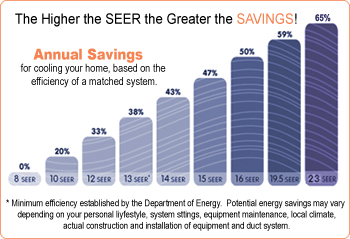What Does The SEER Rating Mean?
 The efficiency of air conditioners is often rated by the Seasonal Energy Efficiency Ratio (SEER) which is defined by the Air Conditioning, Heating, and Refrigeration Institute. Every AC system comes with a SEER rating. The higher the number, the more efficient the unit.
The efficiency of air conditioners is often rated by the Seasonal Energy Efficiency Ratio (SEER) which is defined by the Air Conditioning, Heating, and Refrigeration Institute. Every AC system comes with a SEER rating. The higher the number, the more efficient the unit.
In general, seeking out a model with a higher SEER is preferable because not only will it be highly efficient, but it will be cheaper to run. Although older AC systems have ratings of 6 or even lower, any units manufactured for the US after January 2006 were required to have a minimum SEER rating of 13. Depending on the brand, you can now even find units with ratings of 20 or higher. The energy requirement doesn’t apply to window units, so some of those systems still have SEER ratings of 10.
Central AC systems with ratings less than 9 are rare to see these days because many of these units are being replaced with newer, more efficient ones. If your air conditioner is more than 10 to 15 years old, it could be be time to update. Even if you hate the idea of losing an AC system you’re familiar with, upgrading to a new model truly is worth it. Consider this: the Department of Energy estimates that by upgrading from a 9 to a 13, you can save about $300 per year! Today’s highest quality air conditioners use 30 to 50% less energy to generate the same amount of cooling as air conditioners made in the 1970’s.
The overall performance of an AC system will depend on the SEER, installation, and required maintenance. Contact Wayne Price Heating & Air Conditioning to learn more!
